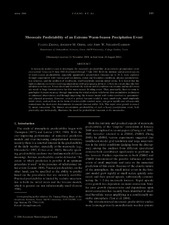| dc.creator | Zhang, Fuqing | |
| dc.creator | Odins, Andrew | |
| dc.creator | Nielsen-Gammon, John | |
| dc.date.accessioned | 2016-10-28T19:29:45Z | |
| dc.date.available | 2016-10-28T19:29:45Z | |
| dc.date.issued | 2006-04-01 | |
| dc.identifier.citation | Zhang, F., A. Odins, and J. W. Nielsen-Gammon, 2006: Mesoscale predictability of an extreme warm-season precipitation event. Wea. Forecasting, 21, 149-166. | en |
| dc.identifier.uri | https://hdl.handle.net/1969.1/158226 | |
| dc.description | © Copyright 2006 American Meteorological Society (AMS). Permission to use figures, tables, and brief excerpts from this work in scientific and educational works is hereby granted provided that the source is acknowledged. Any use of material in this work that is determined to be “fair use” under Section 107 of the U.S. Copyright Act September 2010 Page 2 or that satisfies the conditions specified in Section 108 of the U.S. Copyright Act (17 USC §108, as revised by P.L. 94-553) does not require the AMS’s permission. Republication, systematic reproduction, posting in electronic form, such as on a web site or in a searchable database, or other uses of this material, except as exempted by the above statement, requires written permission or a license from the AMS. Additional details are provided in the AMS Copyright Policy, available on the AMS Web site located at (https://www.ametsoc.org/) or from the AMS at 617-227-2425 or copyrights@ametsoc.org. | en |
| dc.description.abstract | A mesoscale model is used to investigate the mesoscale predictability of an extreme precipitation event over central Texas on 29 June 2002 that lasted through 7 July 2002. Both the intrinsic and practical aspects of warm-season predictability, especially quantitative precipitation forecasts up to 36 h, were explored through experiments with various grid resolutions, initial and boundary conditions, physics parameterization schemes, and the addition of small-scale, small-amplitude random initial errors. It is found that the high-resolution convective-resolving simulations (with grid spacing down to 3.3 km) do not produce the best simulation or forecast. It was also found that both the realistic initial condition uncertainty and model errors can result in large forecast errors for this warm-season flooding event. Thus, practically, there is room to gain higher forecast accuracy through improving the initial analysis with better data assimilation techniques or enhanced observations, and through improving the forecast model with better-resolved or -parameterized physical processes. However, even if a perfect forecast model is used, small-scale, small-amplitude initial errors, such as those in the form of undetectable random noise, can grow rapidly and subsequently contaminate the short-term deterministic mesoscale forecast within 36 h. This rapid error growth is caused by moist convection. The limited deterministic predictability of such a heavy precipitation event, both practically and intrinsically, illustrates the need for probabilistic forecasts at the mesoscales. | en |
| dc.description.sponsorship | National Science Foundation
Office of Naval Research | en |
| dc.language.iso | en_US | |
| dc.publisher | American Meteorological Society | |
| dc.subject | extreme rain | en |
| dc.title | Mesoscale Predictability of an Extreme Warm-Season Precipitation Event | en |
| dc.type | Article | en |
| local.department | Atmospheric Sciences | en |
| dc.identifier.doi | 10.1175/WAF909.1 | |


